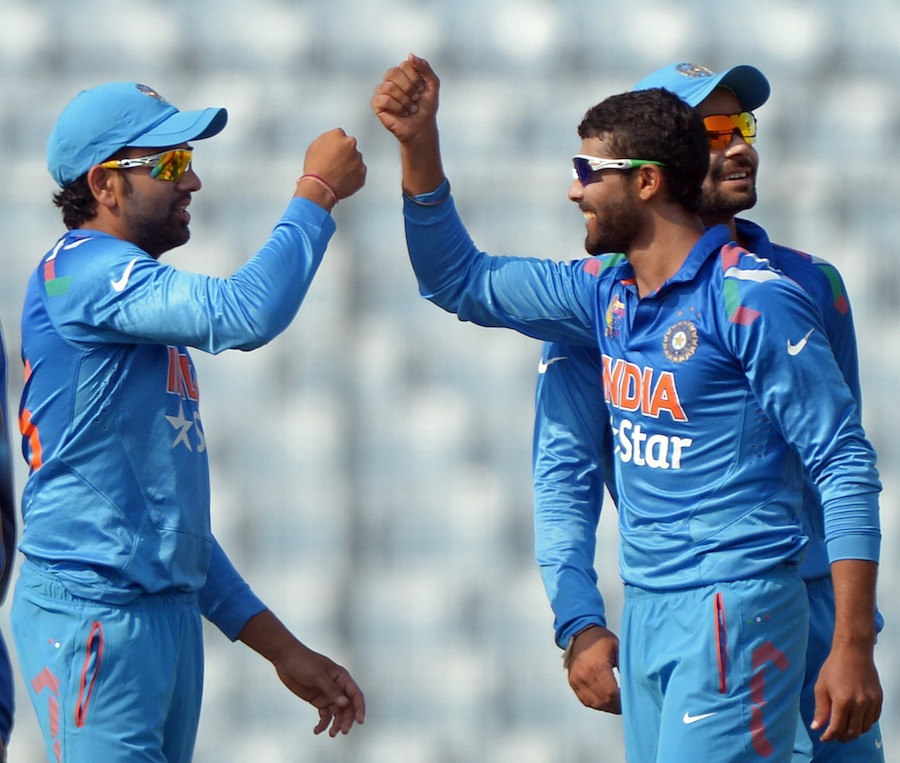Afghanistan’s batting, apart from a match-winning partnership against Bangladesh, has been ordinary, particularly against spin. In a dead rubber against India, and in what was also their last chance to make an impression on this trip, Afghanistan’s batsmen collapsed at the first sighting of turn. Ravindra Jadeja picked up two wickets in his first over, and then added two more to run through a middle order that was clueless against India’s spin trio.
The three of them – Jadeja, Amit Mishra and R Ashwin – bowled unchanged from the 12th over until the 36th with combined figures of 25-3-73-7 during that period. Was it not for another Samiullah Shenwari riposte, Afghanistan could have folded well inside 50 overs.
Batting at No 8, Shenwari brought up his second half-century of the tournament and added 64 runs with the last three batsmen to avoid a capitulation. He farmed the strike, took vital runs off India’s seamers during the Powerplay and despite appearing in trouble against the spinners, he was prepared to attack the loose deliveries. On a day when boundaries were hard to come by, he hit six fours and a six to take Afghanistan past 150.
The Indian team management had decided not to tinker with their playing XI, which meant there was still no place for Cheteshwar Pujara or Ishwar Pandey, the only two in the touring party not to get a game. Kohli, at the toss, mentioned it was important to be patient with the team. But contrary to that logic, they asked Ajinkya Rahane to open the innings with Shikhar Dhawan, instead of Rohit Sharma. The captain, though, couldn’t have asked for more as the openers added 121 runs to set up the chase that India completed in the 33rd over.
Like most teams, Afghanistan showed they were enjoying the challenge of facing the Indian seamers as they collected 52 runs in the first 11 overs for the loss of one wicket. But facing quality spin on these slow and low pitches is a different challenge altogether. The other day, Afghanistan had scored only 40 runs in 16.4 overs of spin from Sri Lanka and lost five wickets. Today, the story was no different. Kohli introduced Mishra, who had been impressive in the match against Pakistan, in the 12th over and immediately, it became apparent the batsmen were out of their comfort zone. Noor Ali Zadran, who had been impressive again the seamers, survived an lbw appeal against a googly first ball. And the next over derailed the innings.
Jadeja’s first delivery – a quick slider that often buys him wickets of batsmen who are slow to come forward – beat Rahmat Shah’s inside edge and thudded on to the pad. His third delivery would have pleased him more; it was slower, loopy, and dipped and then bounced to catch the shoulder of Noor Ali’s bat for Kohli to take a simple catch at slip.
Jadeja’s next over worsened Afghanistan’s position as Asghar Stanikzai slapped possibly the only bad delivery the spinner bowled limply to mid-on. Stanikzai left disappointed, because he knew he could have hit the half-tracker anywhere. What followed was a period of play where a wicket never seemed too far. Like Jadeja, Ashwin had a wicket off his first ball, in the 18th over; Najibullah Zadran heaved at a flighted delivery but top edged to mid-on.
Mohammad Nabi, the Afghanistan captain, was caught behind for 6 off Jadeja in the 21st over and Mohammad Shahzad, who had been pushed down the batting order, scored 22 runs that were not enough to alter the script. When Shahzad was trapped plumb in front by Ashwin, Afghanistan had slumped to 95 for 7.
Mishra, who had figures of 10-1-21-1, was possibly the most impressive of the spinners, beating the bat with metronomic regularity. His legspinners gripped the surface to turn past the outside edge numerous times, while his googlies were unread. After seven overs of bamboozling the batsmen, he too had something to show for his efforts as a googly took Mirwais Ashraf’s inside edge and lobbed to Kohli at slip.
However, he still ended with a wicket less than Mohammad Shami, who had dismissed Nawroz Mangal after a wayward start and then trapped Shenwari lbw in the 46th over to end the innings.
On a slow pitch that required extra application from the batsmen, Rahane and Dhawan adopted the ideal game: there was no attempt to play fancy shots and the two relied primarily on maneuvering the ball in the gaps. In the nine overs before the 45-minute break, the openers added 34 runs, hitting only two boundaries. They continued in the same vein after the break, nudging singles to lift the total to 76 in 18 overs. Again, only two boundaries came in that period.
The tempo changed from the first ball of the 19th as Rahane hit consecutive boundaries off Shenwari. He stepped out first ball and clipped the full delivery over extra cover, a shot to which he can now lay claim as his own just because of the ease with which he pulls it off – he takes it low on the bat and punches it without any follow-through. The second one, a wristy flick against the spin beating mid-on, was even better. Dhawan caught the urgency bug too, hitting consecutive boundaries off Rahmat in the next over, the second bringing the century of the stand, India’s first in 14 ODIs. It was also the first time Afghanistan allowed such an opening partnership, highlighting the strength of their attack.
India’s smooth glide momentarily hit turbulence as they lost both openers in quick succession – Rahane played across the line to be lbw and Dhawan was bowled by Nabi. Rohit Sharma, who walked in at No. 3, and Dinesh Karthik added the remaining 37 runs to complete the formality.
Devashish Fuloria is a sub-editor at ESPNcricinfo.


